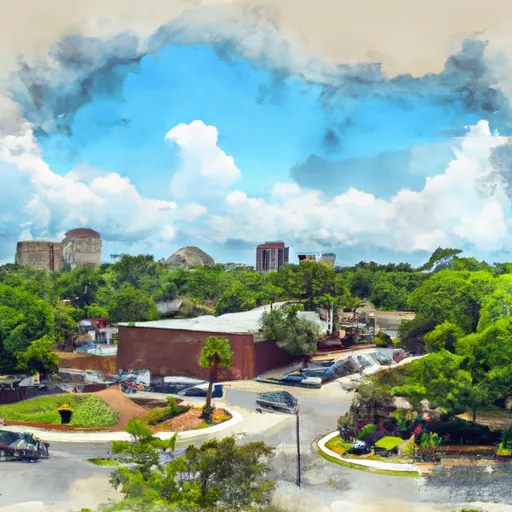-
 Snoflo Premium
Snoflo Premium
Get unlimited access to all our content
With no Ad interruptions! - Start Your Free Trial Login with existing account
Jasper
Eden Index
Climate
7.8
•
Recreation
4.8
•
Community
2.3
•
Safeguard
5.4/10

Jasper, Florida is a charming small town located in Hamilton County, in the northern part of the state. The town experiences a humid subtropical climate, characterized by hot and humid summers with frequent afternoon thunderstorms and mild winters. Average high temperatures in summer range from 90 to 95°F (32 to 35°C), while winter temperatures rarely drop below freezing.
Jasper is surrounded by beautiful natural landscapes and is known for its rich hydrology constituents. The Suwannee River flows just west of the town, providing ample opportunities for water-based activities such as fishing, boating, and kayaking. The area is also home to numerous springs, including the famous White Springs, offering crystal-clear waters to swim in and explore.
Outdoor enthusiasts will find plenty of recreational opportunities near Jasper. The Stephen Foster Folk Culture Center State Park features hiking trails, picnic areas, and a museum dedicated to the famous composer. Big Shoals State Park, located nearby, offers spectacular views of the largest whitewater rapids in Florida and is a popular spot for hiking, cycling, and horseback riding.
In summary, Jasper, Florida, offers a pleasant climate, diverse hydrology constituents, and a range of outdoor recreation opportunities, making it an appealing destination for nature lovers and adventurers.
What is the Eden Index?
The Snoflo Eden Index serves as a comprehensive rating system for regions, evaluating their desirability through a holistic assessment of climate health, outdoor recreation opportunities, and natural disaster risk, acknowledging the profound impact of these factors on livability and well-being.
Climate Health Indicator (CHI): 7.8
Jasper receives approximately
1314mm of rain per year,
with humidity levels near 88%
and air temperatures averaging around
20°C.
Jasper has a plant hardyness factor of
8, meaning
plants and agriculture in this region tend to thrive here all year round.
By considering the ideal temperature range, reliable water supplies, clean air, and stable seasonal rain or snowpacks, the Climate Health Indicator (CHI) underscores the significance of a healthy climate as the foundation for quality living.
A healthy climate is paramount for ensuring a high quality of life and livability in a region, fostering both physical well-being and environmental harmony. This can be characterized by ideal temperatures, reliable access to water supplies, clean air, and consistent seasonal rain or snowpacks.
Weather Forecast
Streamflow Conditions
Suwannee
Area Rivers
Suwannee
Snowpack Depths
Suwannee
Reservoir Storage Capacity
Suwannee
Groundwater Levels
Recreational Opportunity Index (ROI): 4.8
The Recreational Opportunity Index (ROI) recognizes the value of outdoor recreational options, such as parks, hiking trails, camping sites, and fishing spots, while acknowledging that climate plays a pivotal role in ensuring the comfort and consistency of these experiences.
Access to outdoor recreational opportunities, encompassing activities such as parks, hiking, camping, and fishing, is crucial for overall well-being, and the climate plays a pivotal role in enabling and enhancing these experiences, ensuring that individuals can engage in nature-based activities comfortably and consistently.
Camping Areas
| Campground | Campsites | Reservations | Toilets | Showers | Elevation |
|---|---|---|---|---|---|
| General Coffee State Park | None | 216 ft | |||
| Stephen Foster State Park | None | 97 ft | |||
| Ben Hill Landing County Park | None | 161 ft | |||
| Otter Springs County Park | 100 | 19 ft | |||
| Gornto Springs County Park | 24 | 20 ft | |||
| Gibson | None | 65 ft | |||
| Manatee Springs State Park | None | 25 ft | |||
| Shell Mound County Park | None | 7 ft | |||
| Hart Springs | None | 13 ft | |||
| Hinton Landing County Park | None | 19 ft |
Catastrophe Safeguard Index (CSI):
The Catastrophe Safeguard Index (CSI) recognizes that natural disaster risk, encompassing floods, fires, hurricanes, and tornadoes, can drastically affect safety and the overall appeal of an area.
The level of natural disaster risk in a region significantly affects safety and the overall livability, with climate change amplifying these risks by potentially increasing the frequency and intensity of events like floods, fires, hurricanes, and tornadoes, thereby posing substantial challenges to community resilience and well-being.
Community Resilience Indicator (CRI): 2.3
The Community Resilience Indicator (CRI) recognizes that education, healthcare, and socioeconomics are crucial to the well-being of a region. The CRI acknowledges the profound impact of these elements on residents' overall quality of life. By evaluating educational resources, healthcare accessibility, and economic inclusivity, the index captures the essential aspects that contribute to a thriving community, fostering resident satisfaction, equity, and social cohesion.

